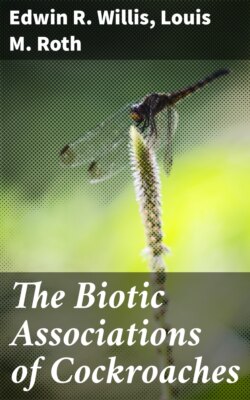Читать книгу The Biotic Associations of Cockroaches - Edwin R. Willis - Страница 111
На сайте Литреса книга снята с продажи.
AQUATIC HABITATS
ОглавлениеTable of Contents
The so-called aquatic or amphibious cockroaches are all members of the subfamily Epilamprinae (Chopard, 1938). These forms are not nearly as aquatic as water beetles or aquatic Hemiptera, but in their relations to water they behave differently from nonamphibious cockroaches, which tend to avoid water except for drinking. There are apparently no special morphological characteristics that distinguish amphibious cockroaches (Shelford, 1907, 1909a; Chopard, 1938), although Takahashi (1926) listed several characters that he considered made Opisthoplatia maculata adapted for an aquatic life: (1) Back of body easily wetted; (2) long hairs on underside of thorax trap air; (3) terminal abdominal spiracles open into tubes that extend rearward; (4) long hairs on ventral surfaces of cerci "protect" terminal abdominal spiracles. Annandale (1906) also suggested that the position of the posterior abdominal spiracles, at the base of tubes that project rearward from beneath the seventh tergite, are an adaptation to an aquatic life. However, as Shelford (1907) and Chopard (1938) have pointed out, this same feature may be observed in many terrestrial cockroaches. The legs of amphibious cockroaches are similar to those of nonaquatic species and are not modified for swimming (Shelford, 1909a; Takahashi, 1926).
Biological observations have been made on relatively few species, but representatives of at least six genera occur in quasi-aquatic habitats. Strictly speaking, these cockroaches live on land at the edges of streams or pools and spend relatively brief periods in the water. A few species are found in water-filled bromeliads. The behavior of the known amphibious species of cockroaches in relation to their habitats is discussed below.
